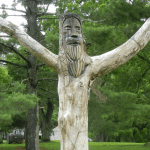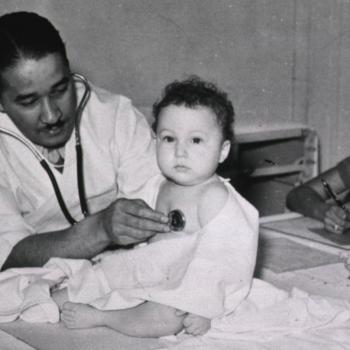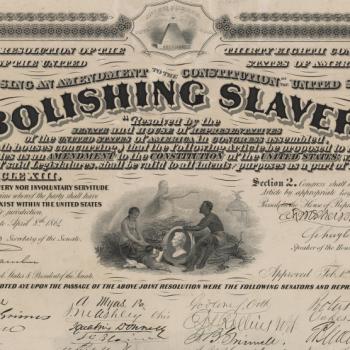I’d like to tell you a just-so story about the Neopagan movement and how it started in the nineteenth century as a response to industrialization.
Set the Wayback Machine for, say, 15,000 years ago — before the Neolithic Revolution, before the dawn of civilization. Our ancestors at this time were gatherer-hunters and their cultures were not very complicated. There was little division of labor, except perhaps by gender.
So if you grabbed a fifteen-year-old boy out of a hypothetical composite pre-agricultural tribe, you could expect him to be competent in every aspect of its culture and technology available to its males.[Campbell 142-144] He might not be the best at tracking game, but he can do it. He might not be the best at chipping an arrowhead, but he can make one. He might not be the best at finding medicinal herbs, but he knows what leaves to chew if he’s got a stomach ache.
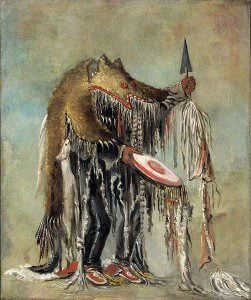
And he might not be the best at going into a visionary, mystical state of consciousness — that person would be the tribal shaman — but he’s had such experiences. In fact he went on a vision quest as part of his initiation into manhood.[Campbell 158](I am using the word “shaman” here in a very broad sense, after Krippner: an individual in a tribe who has access to extraordinary sources of information via deliberate alteration of consciousness, who uses that information of the benefit of the tribe, and is recognized by the tribe as having a special role.[Krippner])
Though there were certainly tribal taboos and myths and rituals, with everyone having direct religious experiences and no possibilities for holy books to be written (this was before writing, remember), it was hard for complex religious dogma to get much of a foothold.
If you skipped back a few thousand years to 20,000 years ago, or forward to 10,000 YA, you’d find much the same. Of course there were differences between tribes, but this general pattern of human existence as tribal gatherer-hunters with shamanistic religion would still hold.
But then agriculture gets going and people settle down in one place to work the land. Villages, towns, eventually cities form. Civilization is born, and with it comes specialization. Life in a agricultural society is too complicated for one person to know it all — indeed it’s so complicated that we have to invent writing to manage it. We get merchants and artisans of all stripes and peasant farmers and warriors and royalty and scribes and middle managers.
And we get priests. The priest is very different from the shaman. A shaman is often “chosen by the spirits” in some way. See for example Black Elk, who fell ill near death for twelve days while he had his first major vision.[Elk 20-48] While they may apprentice to learn techniques, ultimately their power or authority does not come from any other human being but directly from their relationship to the spirit world or the deities. But a priest is trained in their rituals and invested with their authority by other priests, sometimes as a family lineage. Think of the sacrament of Holy Orders and chain of apostolic succession in some Christian denominations, the Jewish kohens in the line of Aaron, the Hindu Brahmin caste, the intensive training of the ancient Druids. Ordinary people no longer have direct and unmediated access to the divine; they go through the priests, whose job is to maintain the complex social order, to make society follow the heavenly order.[Campbell 153-155]
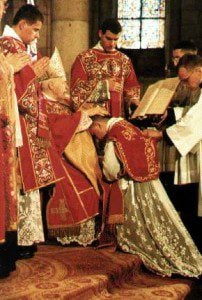
For a long time it was thought that we had agriculture and permanent settlement first, and priestly religion was a subsequent development. But more recent archeology suggests that we were building places of worship 11,000 years ago at sites like Gobekli Tepe (a 25 acre complex of stone circles in what is now Turkey), and that the need to feed and organize worshipers and workers led to the development of agriculture and permanent settlement.[Curry; Scaham; Schmidt]
But whichever came first, they developed together. The new way of making a living in the material world went hand-in-hand with a new way to relating to the deep emotional/mystical/spiritual word.
We are greatly oversimplifying the history of civilization and religion here, and there are scores of exceptions and counter-currents. But if you step back and squint your eyes, this is the picture that emerges: humans in gatherer-hunter cultures with fairly flat social structures and shamanistic spirituality based around individual visions, from behavioral modernity on the order of 50-100,000 years ago up through the Neolithic revolution about 12,000 YA; then the development of hierarchical agricultural civilizations and priestly religion based around complex group ritual from that point up through the end of the Middle Ages in Europe.
If you grabbed an Sumerian from the age of Gilgamesh, about 4,800 years ago, and brought them forward in your time machine 3,000 years to the Roman Empire or 4,000 years to medieval Europe, the general structure of society would not be unfamiliar to him. Who’s the king? (Well, the Romans had an Emperor with a tradition of denying kingship but it was largely a distinction without a difference at that point.) Where’s the temple? Who are the priests? Most people are still working the land, be it as peasants or slaves. Of course you could find “uncivilized” places along the way to drop him off, or exceptional civilizations like democratic Athens, but the general pattern of those ancient Mesopotamian cultures persisted and spread pretty well for a long time.
But just a few hundred years ago we started to get something new. With the end of the manor system in Europe we started to see “cottage industry” — for the first time, a large number of people were involved in economic production other than agriculture. Land enclosure began, commons were privatized, and the feudal lord demanding a share of the peasants crops transitioned into a landlord demanding rent and with the ability to evict.[Greer 245-249, 446-447] In just a few centuries the Renaissance begat the Enlightenment begat the Industrial Revolution.
We could pull that hypothetical Sumerian 4000 years forward from the highest civilization of 2800 BCE to the highest civilization of 1200 CE and they would more or less understand the world in which they found themselves. But if we pulled a European from 1200 CE just 600 years forward to 1800, what a change! The beginnings of science and industrialization, land enclosure, modern democracy. A pattern of civilization that had endured for thousands of years was cracking apart.
We are talking here about a change in human existence as significant as the dawn of civilization, when we went from gatherer-hunters to agriculturalists. And just as that was accompanied by a shift from shamanistic, direct religion to priestly, indirect religion, so this transition will need a new sort of spirituality.
In Part II we’ll look at how intellectuals, spiritual explorers, and fraudulent mountebanks of the nineteenth century responded to their changing world and laid out some of the ideas that would develop into the Neopagan movement.
References
Campbell, Joseph. The Flight of the Wild Gander. New York, N.Y: HarperPerennial, 1990.
Curry, Andrew. “Gobekli Tepe: The World’s First Temple?” Smithsonian Magazine, November 2008. <http://www.smithsonianmag.com/history/gobekli-tepe-the-worlds-first-temple-83613665/?all>
Elk, Black, and John G. Neihardt. Black Elk Speaks : being the life story of a holy man of the Oglala Sioux. Lincoln: University of Nebraska Press, 1988.
Greer, Thomas. A Brief History of the Western World. Stamford: Thomson Learning, 1987.
Krippner, Stanley. “Conflicting perspectives on shamans and shamanism: Points and counterpoints.” Am Psychol. 2002 Nov;57(11):962-78. American Psychologist, Vol 57(11), Nov 2002, 962-977. <http://dx.doi.org/10.1037/0003-066X.57.11.962>, <http://stanleykrippner.weebly.com/conflicting-perspectives.html>
Scham, Sandra. “The World’s First Temple.” Archelogy, Volume 61 Number 6, November/December 2008.
<http://archive.archaeology.org/0811/abstracts/turkey.html>
Schmidt, Klaus. “Göbekli Tepe – the Stone Age Sanctuaries. New results of ongoing excavations with a special focus on sculptures and high reliefs.” Documenta Praehistorica 37 (2010): 239-256. <http://arheologija.ff.uni-lj.si/documenta/authors37/37_21.pdf>
“The Zen Pagan” is now its own blog! We’ll have RSS and e-mail subscription information soon.
My next scheduled events are the Free Spirit Gathering in June and Starwood in July.
If you do Facebook, you might choose to join a group on “Zen Paganism” I’ve set up there. And don’t forget to “like” The Zen Pagan and Patheos Pagan over there, too.



